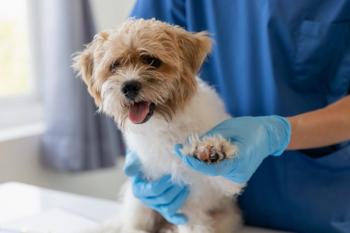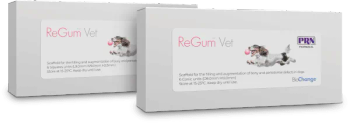
10 veterinary dental hacks from dvm360
A collection of our top tips about veterinary dental care, including getting clients to embrace this important aspect of their pets' health and best practices once you're ready to roll.
We've compiled our most practical advice on everything from getting clients to say “Yes!” to dental care to obtaining perfect oral radiographs to performing nerve blocks. We hope they'll make you smile.
3 dental tips with bite
(Getty Images)1. Dental goodie bags. Include product brochures, free samples for at-home dental products and a $10 discount off dental preventive products that day.
2. Before and after pics. Send them home with the pet owner to show that the money on dental procedures was well spent.
3. Flip book. Keep copies of those “before and after” pics (you don't need to include patient or client names!) in a flip book at the practice to show other clients the importance of dental work.
- Bailey Parker, Wolf Creek Veterinary Clinic, Basehor, Kansas
3 reasons cat owners are saying no to dental procedures
Dr. Karen Felsted, owner of PantheraT Consulting in Dallas, Texas, has practiced veterinary medicine, owned veterinary clinics, consulted in veterinary practices and spearheaded efforts to create and manage data to help hospitals for decades. So she knows some of your pain when it comes to talking up the importance of dentistry.
"Dentistry hasn't really grown that much in the past 20 years for all the talking we've done at meetings and in magazines," she observes.
Harsh. And the reasons, she thinks, are simple but powerful. We could not resist trying to point you to resources to help tackle these three common cat-owner concerns that hold them back from agreeing to needed feline dental work.
PROBLEM 1: "Cat owners are reluctant to bring their cats in for anything."
SOLUTION: Many cat owners hate bringing their cats to the veterinarian, because cats hate coming. First step? Cultivate a generation of cats that don't hate the carrier-or don't hate it as much as they could. Start with this client handout:
PROBLEM 2: "For pet owners, anesthesia is scary."
SOLUTION: They're not a veterinarian like Felsted, so they don't know how safe anesthesia can be and how infrequent complications are.
First, is anesthesia at your practice as safe as it could be? Visit
Second, your team members can help explain how safe anesthesia is. For proof, visit
PROBLEM 3: "Cat owners can be more sensitive to cost than dog owners."
SOLUTION: Data shows cat owners, in general, see veterinarians less and are the beneficiaries of fewer veterinary healthcare dollars than their canine counterparts. The first step is convincing clients that cats need the care. Start getting past clients' bias against spending money on cats by visiting
A good second step? Try
Finally, if your problem with talking about money is you get a little tongue-tied when a cat owner snaps back so quickly with a "no" or "that's so much," try on these talk-focused
The greatest handout you have ever seen
Even veterinary dentists admit they don't brush all their pets' teeth all the time. (Let's be honest: Do you even brush your own teeth all the time? After every meal? Well, aren't you special.)
For those patients that need it and for those special clients who will do it-especially starting with their pets as puppies and kittens-
3 tips to top the charts of dental greatness
Barron Hall, DVM, DACVD, FAVD, a certified veterinary dentist at Animal Dental Clinic in Vienna, Virginia, offers these three tips to keep dental records like a pro.
Your dental record needs to contain more than words to help record critical information about the state of the pet's mouth. Consider this advice:
1. Start with six “before” pictures to document what the teeth looked like beforehand. And if you notice other issues, like a bite that's “off,” you may choose to add more photos.
2. Obtain full-mouth intraoral radiographs in every patient. If you do this, Dr. Hall says you will notice problems both in areas that look abnormal and in areas that look fine.
3. Have a dental chart-NOT a 2-inch by 3-inch stick on post-it. You need a full page of paper that lets you document each tooth-all 42 “patients” in a dog's mouth and all 30 “patients” in a cat's mouth.
Check out the
Dr. Hall says he prefers to use two dental charts-the first to show pathology and the second to show the procedures performed that day.
5 real world dental radiograph hacks
Veterinary dentist Dr. Heidi Lobprise presented these gems at a recent CVC.
1. A tree at noon casts no shadow. If you aim the x-ray perpendicular to the film, when the tooth and film are not right up against each other, it's much like a tree at noon that casts no shadow. So an x-ray perpendicular to the film is too short.
2. Flexible spiral perm rollers can save the day. They're ideal for keeping your sensor or the film in the mouth easily, and they work as soft mouth gags too.
3. Tamp down your type A personality. Remember, radiographs need to be diagnostic, not perfect. So take a breath and take your next radiograph.
4. Use those opposable thumbs. Dr. Lobprise says, "When I'm teaching people to identify what tooth is on the film, as I'm looking at the film I have them lift up their fingers and I have them match their thumbs to the distal root of the upper fourth premolar, their fingers to the two front roots, and when it matches up-thumb, two fingers-then that's the side of the mouth that the tooth is on-for example, the upper right fourth premolar." (Watch the video for visual demonstration.)
5. Be the beam. If you're not a very visual person, imagine you are the beam. Where would you need to go through the tooth to make an image on the film?
Visit
Client handout: 5 signs of dental pain in pets
(Getty Images)Mouth pain stinks, and pets just don't deserve to suffer in silence. Your quickest path to compliance may be client education. Once pet owners believe their pets may be in pain, they may be more likely to seek your help.
Dental tip: Create a safer gag
So instead, try this quick tip to make your own gentle mouth gag.
1. Find a 25-ga needle cover.
2. Cut the closed end off.
3. Place between the maxillary and mandibular canines.
Voila! Your gag is complete.
A few dentistry-focused Idea Exchanges
Unplug applicators with a dental tool
Our Doxirobe gel (Pfizer Animal Health) needle applicators kept getting plugged when we administered the gel over several days. But then I discovered a way to unplug them. With the dental machine turned on, I put the tip of the air-water handpiece into the applicator and sprayed air through it. The gel sprayed out both ends, and the applicator was completely clean and ready to use again.
Trenton Oberly, veterinary technician, Chandler, Arizona
Gloves let you get a clean grip
When performing a dental prophylaxis, my hands get messy and no doubt covered in bacteria, and then I have to pick up my pen to note results in the patient's chart. So now I put my pen through the finger of a rubber glove and discard the glove when I'm finished. My pen stays clean, and I don't pass along any bacteria.
Vicky Vantlentenryck, veterinary technician, Upper Montclair, New Jersey
Prevent injuries by casing dental equipment
Our dental scaler with a high-speed drill is quite sharp. It can be dangerous if you brush against it, so when it is not in use, we place 30- or 60-ml syringe casings over the top to prevent injuries.
Beth Shepherd, veterinary assistant, Grass Lake, Michigan
A day in the life of a dental patient
We have a dental tour video in all our exam rooms. After recommending a dental procedure, the doctor turns on the video and leaves the room, and clients get to see what goes on behind the scenes when their pets are here.
Rachel Arden, technician, Streamwood, Illinois
Keep cleanup simple with an E collar
Using an ultrasonic scaler during dental procedures can get messy, especially with multiple extractions. To make patient cleanup quicker and easier, we place an Elizabethan collar on the patient, with the wider, more open end covering the animal's shoulders and neck. The collar protects the patient from getting water, blood, or polish on its fur, making cleanup a snap. If you clean and dry the collar once the dental procedure is done, you can use it multiple times.
Crystal Davis, LVT, Hampton, Virginia
Start a social media campaign
(Getty Images)
The details on performing four oral regional nerve blocks
Newsletter
From exam room tips to practice management insights, get trusted veterinary news delivered straight to your inbox—subscribe to dvm360.






